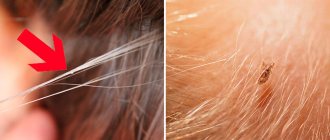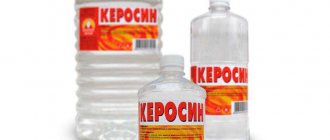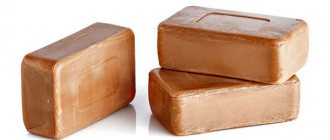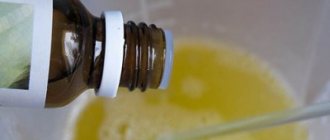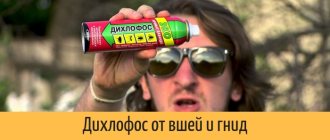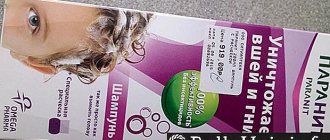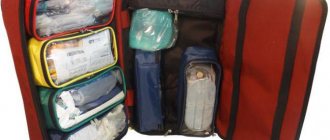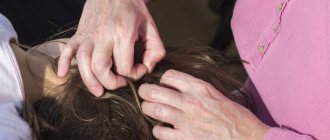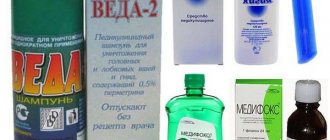Table vinegar
A common sense approach, acetic acid dissolves the thick adhesive film that cements nits at the base of the hair. As a result, they can be easily removed from the hair.
To avoid burning the scalp, the vinegar was diluted with water, coarse salt was added, and to be sure, a little alcohol, which also dissolves the protective capsule of the nits. This method has a significant drawback - vinegar in combination with alcohol dries out the hair, turning it into a washcloth, and also irritates the scalp, which is already scratched from insect bites.
How to remove lice in 1 day and forever
The fight against parasites must be comprehensive. Simply washing your hair with anti-lice shampoo does not guarantee that lice will disappear. They can remain on personal belongings, bed linen, towels, or just on different surfaces in the house. After washing and combing the hair, when, it would seem, all the parasites have been destroyed, the lice remaining in the house will easily move onto the hair and continue to plague the victim. To prevent this from happening, the technique should be like this:
- thoroughly wash your head and body with an anti-pediculosis agent (pharmacy, professional insecticide); nits can hide under skin flakes, so you need to wash the whole thing;
- after washing, comb your hair thoroughly with a special comb with a small distance between the teeth; it is better if another person does this, using a magnifying glass, so as not to miss a single nit or adult;
- wash all personal items at high temperature; you can pre-soak them in a pediculicide solution;
- things that cannot be washed should be placed in sealed bags and left for 2-3 weeks: if they contain parasites or their eggs, during this time without food they will die, after which the item must be cleaned of remains;
- carry out general cleaning, treating all places where insects may be located with a solution of a special insecticide; you can use a steam generator;
- Anti-lice treatment should be carried out on all family members, even if only one person has signs of head lice.
The only way to get rid of parasites faster and permanently is to shave your head bald. But it is not suitable for everyone. In other cases, it is necessary to understand that the key to a successful fight is to pay attention to the problem and use professional means.
All of the indicated remedies and methods for getting rid of nits and lice are suitable not only for head lice, but also for other types - pubic and bed lice.
Source
First generation of anti-pediculosis drugs
These drugs are based on permethrin, a toxic insecticide that has a paralyzing effect on insects. It also poses some danger to humans, therefore it is not recommended for use in children under 6 months, pregnant and lactating women. In addition, permethrin-based preparations cause the gradual development of resistance in lice and nits. According to statistics, about $74 of parasites today are already resistant to the effects of permethrin, so such drugs show low effectiveness.
What causes lice
Despite popular belief, lice do not only affect people who do not maintain personal hygiene or lead an antisocial lifestyle. It is much easier to catch parasites than to remove lice. They easily transfer to the scalp and hair when using personal items, bedding, or simply from another person. Insects move quite quickly and can remain outside the human body for some time. They even survive in water or at high air temperatures, so you can become infected with them, for example, in a pool, sauna or on the beach. Very often, lice are picked up in crowded places - in transport, hospitals, children's institutions. There is no guarantee of protection from this scourge. Everyone is at risk of becoming infected.
A new word in the fight against pediculosis
Dimethicone and mineral oil have long been used not only in the production of cosmetics, but also in pharmacology. In the first case, they give creams, serums, and balms a plastic consistency, make them more comfortable to apply, retain moisture and create an impenetrable protective film. Dimethicone is the active ingredient in anticolic drugs for infants.
Substances that are safe and so useful for humans turned out to be lethal for the insects that parasitize them. Lice breathe through the surface of the body - there are 4 pairs of spiracles on the sides through which air penetrates. Nits, firmly fixed to the hair with cementing glue-saliva, receive only air from the outside; their supply of nutrients is located under the shell of the egg. Dimethicone and mineral oil, which became the basis of PARANIT pediculicidal products, are easily distributed throughout the hair and tightly clog the respiratory passages of lice and nits. Deprived of the ability to breathe, they quickly die. For the product to be as effective as possible, it must be applied generously, thoroughly moisturizing each strand.
The active ingredient of PARANIT preparations is safe for humans. "PARANIT Sensitive" is suitable for children under 3 years of age, pregnant and lactating women. Anti-pediculosis products are available in various forms: shampoo, spray, lotion. Due to their oily consistency, they are easily distributed throughout the hair and do not drip. To make rinsing easier, you can use PARANIT shampoo-conditioner.
Another advantage of PARANIT products based on dimethicone is the lack of resistance in lice and nits. The drug acts physically, blocking the access of oxygen, so insects cannot adapt to it and develop resistance. Even repeated use of drugs helps to eliminate parasites just as effectively without harm to health and hair.
Pediculosis is not scary if you don’t have folk remedies for lice on hand, but a modern, safe “PARANIT” that can easily get rid of uninvited guests, preserve your hair and help prevent the appearance of parasites in other family members.
Where do lice come from?
The louse is an ectoparasite of humans; it lives only on humans and feeds only on human blood. You cannot get lice from animals. There are many reasons why lice appear, but they can only be transmitted from person to person.
There are several ways of infection:
- Direct contact - from head to head. This most often affects children. In a group, on a walk, during games, they touch their heads, hug - at this time the insects quickly crawl from one to another.
- Through personal items, especially hats, hair accessories, combs, but also clothing, towels, etc.
- Through bedding and accessories, lice can be found both on their surface and in the thickness of blankets, pillows, rugs.
- In transport - either through close contact with an infected person, or you can catch lice on soft seat upholstery, bedding on trains, or simply on any surfaces.
- Surprisingly, in the pool, sauna, spa and other establishments with high humidity, as well as on the beach. These insects are not at all afraid of water and can live in it for some time.
- Just on the street or in any room, being next to an infected person. For example, a person with lice could get up from a bench, leaving an insect on it that had fallen from his head, and then another person sat down on the same bench, leaning against the back, from where the parasite moved onto him in a matter of seconds.
In a word, no one is safe from this misfortune. Lice can appear in people of any age, gender, social status and hygiene habits.
Methods for getting rid of lice and nits
The fastest way to get rid of lice
The fastest way, which is not suitable for everyone, is to shave your head. Head lice move only on hair, and they also lay eggs only on hair. If there is no hair, then there are no lice. This method is the most effective. The head needs to be shaved, and then, to be on the safe side, you can wash it with anti-pediculosis shampoo to remove any remaining insects and nits that might remain between the skin scales. One such treatment is enough to get rid of lice forever. Care must be taken when processing. The cut hair must be carefully removed, and the room in which the shaving was done must be washed with insecticidal agents so that there are no living parasites and nits left in it. Lice live outside the human body for up to two days, and nits in a state of suspended animation for up to 10 days, after which, once in a favorable environment, they will live and develop further. To prevent this from happening, it is worth taking measures.
Folk remedies
Those with long hair will most likely not agree to get rid of it in order to cure lice. Traditional methods can also be used to remove lice and nits. Most often, folk remedies are used to remove lice from a child. It is believed that such time-tested methods are the most effective and safe.
Mechanical methods
To eliminate the use of any drugs altogether, you can use a comb. It is better to take a special comb with very fine teeth. Before treatment, be sure to cover your shoulders with a towel.
Methodology:
- Wash your hair with regular shampoo and treat only wet hair;
- secure them to the top of the head, separating them from the bun for processing one strand at a time;
- comb thoroughly along the entire length, starting from the very roots;
- after each combing, rinse the comb thoroughly under running water, washing away the adults and nits remaining on it;
- The combed strands are secured in a second, “clean” bun.
This method is suitable for people with not very long and not too thick hair and a slight lice infestation. The difficulty is that you can miss parasites. And if you leave at least one louse or nit in your hair, then in a week they will breed again. The procedure will have to be repeated several times to completely eliminate the presence of nits and adult individuals in the hair.
Kerosene
Attention! This method is considered proven, but it can cause a severe allergic reaction or burn. You need to act very carefully.
There is no need to apply pure kerosene to your hair. In order for it to linger on the head for effect, you need to prepare a mixture of a tablespoon of kerosene, two teaspoons of vegetable oil and a teaspoon of shampoo. For long and thick hair, double the amount of ingredients.
Apply this mixture to dry hair so that it saturates the hair to the roots. Put a plastic cap on the treated hair and wrap your head with a towel. The time required for exposure is 2 hours. For children, exposure time should not exceed 1 hour. After treatment, wash your hair with regular shampoo and rinse with a weak solution of vinegar. After washing, be sure to comb your still damp hair with a fine-tooth comb. After three days, this procedure must be repeated.
The disadvantage of this method, in addition to toxicity, is that in low concentrations kerosene may not kill nits, since they have a very dense shell. But in strong concentration it is dangerous to use it, and it is absolutely forbidden to treat children.
Vinegar
Note! Vinegar rinsing is useless against adults. But it dissolves the substance with which nits are attached to the base of the hair. Therefore, a vinegar solution is supplemented with kerosene treatment.
The vinegar concentration should not exceed 9%. This is important to ensure safety and avoid burns. To rinse, part vinegar is dissolved in two parts water. For the best effect, the solution is applied to the hair, the head is wrapped in polyethylene and a towel, the mask is left on the hair for half an hour to an hour, after which the hair is thoroughly combed and washed off with shampoo. You can repeat the procedure for several days in a row, but you should not get carried away, as vinegar can change the color and structure of the hair and cause irritation of the scalp.
Symptoms of nits
It is not always possible to immediately recognize lice eggs; sometimes they are mistaken for dandruff
Therefore, it is important to pay attention to the signs indicating the presence of head lice. The main symptom of the disease is itching where insects and nits accumulate. At night it intensifies and prevents a person from sleeping
Over time, redness and local irritation occur in areas where the skin is scratched.
At night it intensifies and prevents a person from sleeping. Over time, redness and local irritation occur in areas where the skin is scratched.
Lice eggs, unlike dandruff, cannot be shaken off your hair. They are securely attached by the female and can only be combed out with a comb or comb. If the nit is not dead, then when you crush it with your fingers, a characteristic click will be heard and liquid will be released.
Another sign of lice is bluish-red spots on the skin. They occur after an insect bite due to hemorrhages and the concentration of hemoglobin breakdown components. The size of the spots can reach 1 cm in diameter. A rash, purulent blisters and small papules often appear on the affected skin.
Due to illness, not only a person’s sleep is disrupted, but also their appetite. There is general irritability, anxiety, and the temperature may rise. Problems with the digestive, nervous and cardiovascular systems often arise.
REFERENCE! You can detect nits and not confuse them with dandruff using a magnifying glass or Wood's lamp.
How dangerous are ectoparasites and how to exterminate them
The appearance of lice should be taken as seriously as possible. When scratching the head, wounds form on the skin. If an infection gets there, the lesions fester. With good immunity, the sores heal quickly, but if the baby is weakened, a secondary infection occurs. At best, it can be defeated with local wound treatments; at worst, you will have to undergo a course of antibiotic therapy.
But the danger of these insects is far from being biting and itching. The main thing you need to protect your baby from is typhus. This is a severe infectious pathology. The causative agent of typhus is Rickettsia. Signs of infection include high fever, chills, vomiting and intoxication. The rod enters the bloodstream through the saliva of the parasite. Children of different ages get sick equally. Typhus is transmitted transmissibly (through blood).
When insects are first discovered, parents often do not know how to treat head lice, where to get the products and how to use them. Not everyone decides to go to the hospital. Modern pharmacology offers a lot of drugs for this disease in the form of:
- creams;
- shampoos;
- solutions;
- sprays;
- ointments;
- lotions.
Medicines differ in their mechanism of action and composition. The pharmacy will sell the necessary product without a prescription, but it is better to go to a specialist. He will explain how to get rid of insects quickly and not harm the child.
Many drugs in medicine have limitations and side effects. Therefore, you should read the instructions before use. If you are intolerant to chemical insecticides, you can use mechanical methods and home recipes.
Preventive actions
Once children are faced with such a problem at least once, they are unlikely to want to exchange caps or scarves anymore. But, unfortunately, children are rarely able to immediately adequately assess the degree of threat.
However, knowing how to cure head lice in a child is not enough. Prevention of re-infection is also necessary.
Recommendations for preventive actions for them are the same as for adults:
Do not use other people's hats, hairpins, combs or any other things that come into contact with hair; Be careful in public transport: do not lean on headrests, try not to lean against strangers; In swimming pools or saunas, it is best to use a waterproof head cap; Periodically check the child’s head for nits; You can sometimes use shampoos against head lice.
Find out more about preventing head lice in children on this page.
Lice can affect not only children, but also be transmitted from them to adult family members. If a child has parasites, it is necessary to notify the teachers where he is studying. Learn more about the causes of lice.
Find out more about lice in a child, what to do for treatment and how to prevent their development from this video:
Outbreaks of lice must be contained as quickly as possible to prevent the disease from gaining alarming momentum. It is worth explaining to a small member of society why this infection is dangerous and why it is necessary to immediately tell their parents about it.
What happens if you don't remove lice?
The main symptom, sign and unpleasant factor when infected with lice is severe itching. It is impossible to live in peace when your head is constantly itching. Therefore, they try to remove lice as quickly as possible. However, in some cases, people do not pay attention to the itching. This may be due to decreased sensitivity of the scalp or other reasons. Some may feel that their itchy scalp is due to an allergy to shampoo, water, or hats. If itching does not interfere with your life, you should pay attention to other symptoms of lice infestation:
- the appearance of insects - they can be seen with the naked eye, since the female’s body length reaches 0.4 mm, insects move along the hair, so with a certain amount of observation they can be noticed; if the hair is thick, you can comb it - when combing, you can find parasites;
- the presence of nits - lice eggs: these are very small white balls at the roots of the hair, with a large accumulation they are visible;
- bloody bite marks - when piercing the skin, the louse injects a substance into the skin that prevents the blood from clotting, so that a drop of blood flows out and remains on the surface; tangled and glued hair that forms mats: they stick together due to waste products of lice;
- with severe damage and a large number of parasites, an unpleasant odor emanates from the hair.
What medications can be used from an early age?
Children who are not yet a couple of years old are very sensitive to various toxic substances, so it is necessary to select a medicine with extreme caution. Let's get acquainted with the line of least toxic substances, thanks to which you can get rid of parasites in the shortest possible time:
- Parasidosis.
Can be used starting from three months of age. The product contains coconut acid, which has the ability to kill parasites. Also, the composition of the product is made in such a way that the active substances dissolve the sticky secretion that attaches nits to the hair. Using the cream is simple - you just need to apply it to the scalp, rubbing it lightly into the root zone. Wait about 40 minutes, then rinse with regular shampoo. The drug should not be used by persons who have bronchial asthma, as well as by people with individual intolerance to the components of the drug. - Nyuda.
Can be used by children who have already reached 1 year of age. It contains dimethicone, which clogs the airways of parasites with oil, causing them to suffocate. Spray the spray onto dry hair, distribute evenly and leave on for about 40 minutes. Wash off with regular shampoo. It is not prescribed to children who have skin diseases, as it may cause an exacerbation of the disease. - Para Plus.
The aerosol can be used from 1 year. The scalp must be thoroughly treated by thoroughly spraying the spray directly onto the hair roots. Leave for about 10 minutes, rinse with shampoo. The trouble is that the spray has a rather pungent and unpleasant odor. - Tar soap.
It can be used for children at any age, but it is worth remembering that soap with the addition of tar has a very unpleasant smell that your baby may not like. However, our grandmothers also used this remedy to remove lice - both from adults and children. To kill parasites, you need to apply tar soap to the root zone, thoroughly rub the soap into the scalp and leave it for 10 minutes. Using a fine comb, remove parasites from your hair. Here it is necessary to note an important nuance - soap must be used for a very long time, at least 2 weeks. Only in this case will you be able to completely kill the parasites without the chance of relapse. - Anti Bit.
This is a shampoo that is used if a child needs to remove lice, but has reached the age of two. Lather your hair with shampoo - thoroughly, lather well and leave for 5 minutes. Afterwards, rinse and comb the hair well with a fine-tooth comb to remove dead parasites and nits. The advantage of this shampoo is that it has almost no odor, but at the same time the product allows you to eliminate lice in the shortest possible time.
What kind of insects are these?
Small parasites that live on the hair are called lice. Lice in children are found only on the head. These insects reach no more than 5 mm in length. They are reddish-brown or grayish-white in color. They move quite quickly on three pairs of legs, and contrary to popular belief, they cannot fly or jump. As a rule, the female is larger than the male.
Lice feed on human blood; animals are not suitable for them. The life cycle is within 2 months, they have a rapid reproduction property. The liquid released into the wearer's skin causes discomfort, itching and can even lead to illness.
Without hair, the parasite cannot live for more than two days, so it quickly looks for a new host. It can be transmitted in a variety of ways, but usually through direct hair-to-hair contact. The greatest accumulation of lice most often occurs behind the ears and in the back of the head; here the child’s hair is thickest and therefore warmer. In the same place you can find their eggs, covered with an adhesive substance - these are nits. They are difficult to identify, especially in light hair, so it takes a lot of effort to remove them.
Nits in children
The nit looks like dandruff. It has an oval and oblong shape, approximately 1.2 mm in size, and the nits are light, almost transparent. The female secures them with an adhesive substance that is difficult to remove, one larva for each hair. As a rule, the distance from the root is up to 4 cm.
During her life, a female can make up to 250-400 eggs. It lays approximately 7-12 pieces per day. After a week of existence, a new small parasite emerges from the egg - a nymph louse. It takes about a month before the nymph reaches puberty. Unfavorable factors may keep the egg from developing a little longer. The delay occurs at temperatures less than 22 and more than 40 degrees.
It should be noted that the nit is only the shell of the egg and does not in any way affect the development of the insect and its nutrition. Full or empty nits cannot be distinguished with the naked eye. It is quite difficult to remove and can only be removed with hair loss.
https://youtube.com/watch?v=YhNfS7r7_Mg
What is the danger of lice and their larvae?
The most unpleasant consequence of nits is the appearance of a louse. It is the louse that harms the child:
- Allergic reaction;
- Constant itching of the scalp;
- Ulcerative and pustular lesions;
- Irritability and absent-mindedness;
- Infection of scratches and wounds;
- Decreased concentration;
- Sleep disturbance;
- Sometimes - typhus and relapsing fever.
In medicine, lice infestation is called pediculosis. The danger of serious diseases lies not in the parasite bite itself, but in the contact of the damaged part of the skin with the liquid and feces that appear after crushing the louse. Nits do not create an unpleasant sensation other than the feeling of a dirty head and discomfort.
After removing lice and nits, the most important thing is not to forget to heal scratches and wounds on the head after parasite bites. Self-medication can only cause harm
You need to see a dermatologist. He will be able to choose the best products for different skin types. As a rule, the doctor prescribes antihistamines. Wound healing creams are also relevant. Sometimes, after severe infection, ultraviolet irradiation is prescribed.
Prevention of head lice
The basic rule of prevention is conscientious and regular adherence to hygiene rules. That is, frequent change of linen (underwear and bed linen), washing the body more than 2 times a week. But even compliance with this condition does not guarantee 100% against infection. Scientists have proven that these parasites love clean skin and select a host who frequently washes their hair. It is easier to suck blood on this head, since there is less secretion from the sebaceous glands.
It is recommended to check the child’s head for the presence of nits and parasites at least once a month. It is during this time that the incubation period occurs, and lice are easiest to identify and remove. It is advisable to wash bed linen in water at elevated temperatures, and also iron the seams with a hot iron.
After washing your hair, you can treat the area behind the ears, as well as the back of the head, with lavender oil or tea tree extract. Before going to bed, your head should be thoroughly dried with a hairdryer, and not left wrapped in a towel.
Is treatment possible?
The lice themselves are practically invisible; pediculosis is diagnosed by the presence of their eggs - nits.
It is also not very easy to detect them, but it is possible with a careful look. It is getting rid of nits that allows you to completely recover from pediculosis, since the eradication of adult individuals alone is superficial and ineffective even in the short term. But how to eliminate them in children?
Their skin is more delicate, their hair is damaged much more easily, and therefore standard methods of treating head lice in children need to be adjusted taking these factors into account.
Important: if your child is less than one and a half to two years old, or he suffers from a severe form of allergies, asthma or chronic bronchitis, then it is better not to do home treatment and take the baby to the doctor.
For healthy older children, home therapy is generally suitable, provided the recommendations outlined in this article are followed. Therefore, below we will examine in detail the question of how to get rid of nits in a child’s head.
Pros and cons of folk remedies
There are different ways to remove lice at home from children and adults. Traditional methods have many advantages:
Thanks to the above benefits, folk remedies are quite popular. In addition, they are relatively safe. But it is important to consider some disadvantages:
You may be interested in: Ingrown toenails: treatment at home, causes and prevention
Home methods are in demand due to their safety. The main thing is to choose the most suitable method of treating head lice. And then you will be able to get rid of it as quickly as possible.
Can children attend school and kindergarten after treatment?
Parents often withhold information that their child has lice. This cannot be done, since lice are contagious to others. Anyone who has been in contact with an infected child in the past three weeks should be informed about the parasites. This measure:
- It will help infected people to detect parasites before the first symptoms of head lice appear and stop the epidemic.
- Reduces the likelihood of re-infection.
Dr. Komarovsky says that a child can go to school or kindergarten the next day after using the anti-parasite remedy
It is important that there are no living individuals left under the hairline. Parents should comb their children's hair daily to look for new lice.
To avoid infecting others, the student must:
- Avoid direct contact with other children.
- Do not use other people's combs, hairpins, towels, or hats - these are the main causes of lice. The child should place his things separately from others.
Acid and phytoncides
How to remove lice using folk remedies? Acids and phytoncides are also used for this. These products provide quick and effective results:
